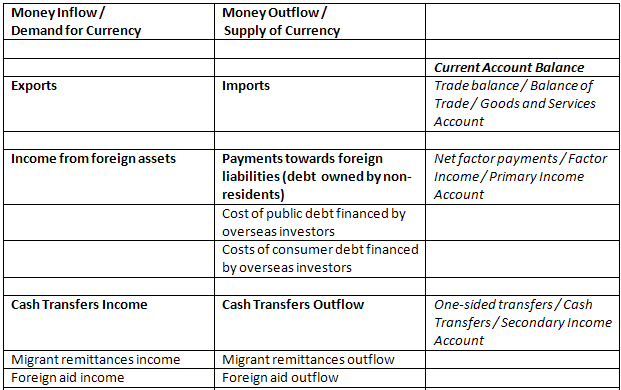The Current Account and how Money Flows
Do you understand how Public Deficits, Foreign Debts, trends in Currency Exchange Rates and Current Account Deficits impact the investment opportunities in the different markets around the world? To do so, a sound understanding is required of each of these economic concepts and how they interact with each other.

This article is a first in a series of five that explains the economic concepts of Current Account, Capital Account and Reserve Account and how they relate with foreign debts and public deficits. If you are interested to get an understanding of how the economy works, how money flows between nations and its impact on currency trends and the economic well-being of nations, please read on.
If you just want to know more about stock market signals that tell you when to buy or sell your funds, please read here more about Stock Trend Investing.
This article focuses on the Current Account.
Current Account
The Current Account Balance is the difference between the inflow and outflow of money into and out of a country from the trade in goods and services, investment income and cash transfers. The Current Account is a report that covers a certain period; often a year.
The following components of the Current Account Balance cause an inflow of money. This means that foreign currencies are used (in general by foreigners) to buy the domestic currency to make payments to residents of the country.
The 3 components that cause a demand for the domestic currency are:
- Exports: the domestic currency is in demand by foreigners to pay for goods and services.
- Income from foreign assets: domestic residents own foreign assets and get compensated for this ownership via dividends, rent, interest and etcetera. This income has its origin in a foreign currency and creates a demand for the domestic currency when converted into this domestic currency.
- Cash transfers from overseas: e.g. incoming remittances from migrants and incoming foreign aid. Both are originally in a foreign currency and create a demand for the domestic currency when exchanged.

Supply of the Domestic Currency
The 3 components that cause an outflow of money are the opposites of the 3 mentioned above. The domestic currency is then used to buy foreign currencies to make payments abroad. Money is leaving the country and the domestic currency is supplied to pay for it.
The 3 components of the Current Account that cause supply of the currency on the international markets are:
- Imports: the domestic currency is offered in exchange for foreign currencies to pay for the imported goods and services.
- Payments towards the foreign holders of domestic debts. The foreign investors who bought/financed the domestic public, corporate or consumer debt need to get their interest paid. These investors in general want their proceeds in their currency and the domestic currency thus has to be offers to buy these foreign currencies.
- Cash transfers out of the country.
Once our next article in this series is published, click on “next” below for the explanation on the Balance of Payments concept and to be introduced to the Capital Account. This is where deficits in the Current Account are financed.
The following articles may also have your interest:
History of US federal debt as percentage of GDP: Why is this now important?
Debt or Deficit: are we into trouble compared to other countries?
Factors contributing to Economic Growth and Causes for Recession and Economic Crisis
Why is the Japanese Yen so Strong?
Next & Previous Blog Post
- ‹ previous
- 49 of 174
- next ›


